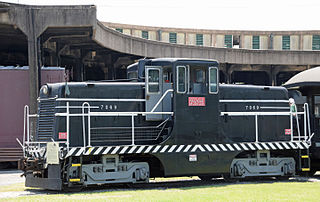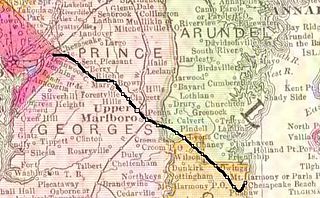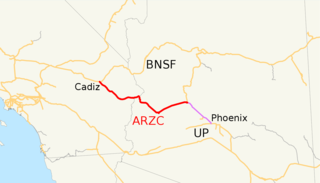
The Grand Trunk Western Railroad Company was an American subsidiary of the Grand Trunk Railway, later of the Canadian National Railway operating in Michigan, Illinois, Indiana, and Ohio. Since a corporate restructuring in 1971, the railroad has been under CN's subsidiary holding company, the Grand Trunk Corporation. Grand Trunk Western's routes are part of CN's Michigan Division. Its primary mainline between Chicago and Port Huron, Michigan serves as a connection between railroad interchanges in Chicago and rail lines in eastern Canada and the Northeastern United States. The railroad's extensive trackage in Detroit and across southern Michigan has made it an essential link for the automotive industry as a hauler of parts and automobiles from manufacturing plants.

The Livonia, Avon and Lakeville Railroad is a short line railroad that operates in Livingston County and Monroe County in New York, United States. The railroad interchanges with CSX at Genesee Junction in Chili, New York, the Rochester and Southern Railroad (RSR) at Genesee Junction and the RSR's Brooks Avenue Yard in Gates, New York, and with the Rochester & Genesee Valley Railroad Museum at Industry, New York. Their primary freight consists of food products - grains and corn syrup. In 1997, the Livonia, Avon and Lakeville Railroad was selected as Short Line Railroad of the Year by industry trade journal Railway Age. The LAL is also the parent company for the Bath and Hammondsport Railroad, the Western New York and Pennsylvania Railroad and the Ontario Midland Railroad.

The Lehigh and Hudson River Railway (L&HR) was the smallest of the six railroads that were merged into Conrail in 1976. It was a bridge line running northeast–southwest across northwestern New Jersey, connecting the line to the Poughkeepsie Bridge at Maybrook, New York with Easton, Pennsylvania, where it interchanged with various other companies.

The Middletown and New Jersey Railroad is one of two railroads in the city of Middletown, New York; the other being its interchange partner, Norfolk Southern Railway. The MNJ consists of 43 miles (69 km) of track in southeastern New York serving Orange County and the Hudson Valley. The railroad also operates and has trackage rights on three additional branch lines totalling 40 miles (64 km) leased from Norfolk Southern in Orange County. It was known as the Middletown and New Jersey Railway until 2009, when East Penn Railroad parent Regional Rail, LLC bought the line through a new subsidiary. In 2015, Regional Rail was in turn acquired by Levine Leichtman Capital Partners ("LLCP").

The GE 44-ton switcher is a four-axle diesel-electric locomotive built by General Electric between 1940 and 1956. It was designed for industrial and light switching duties, often replacing steam locomotives that had previously been assigned these chores.
The Santa Maria Valley Railroad is a 14.8 miles (23.8 km) shortline railroad that interchanges with the Union Pacific Railroad's Coast Line at Guadalupe, California. As of 2006, the Railroad is owned by the Coast Belle Rail Corporation.

The Toledo, Peoria and Western Railway is a short line railroad that operates 247 miles (398 km) of track from Mapleton, Illinois, through Peoria across Illinois to Logansport, Indiana. TP&W has trackage rights between Galesburg, Illinois, and Peoria, between Logansport and Kokomo, Indiana, and between Reynolds, Indiana, and Lafayette, Indiana. TPW has connections with UP, BNSF, NS, CSXT, CN, CP, BL, CERA, CIM, KBSR and T&P. The railroad is now owned by Genesee & Wyoming Inc. The railroad's traffic comes largely from agricultural products, including both raw and processed grain products, as well as chemicals and completed tractors. The TPW hauled around 26,000 carloads in 2008.

The High Bridge Branch is a branch line that was operated by the Central Railroad of New Jersey (CNJ). As built, the branch started in High Bridge, New Jersey at a connection with the CNJ main line and continued north to iron-ore mines in Morris County. The High Bridge Branch line followed the South Branch of the Raritan River for much of its duration.
B&H Rail Corporation, formerly the Bath & Hammondsport Railroad, is a Class III shortline railroad. Initially the line served the communities of Bath, New York and Hammondsport, New York. In Bath, the railroad connected with the Erie Railroad and the Delaware, Lackawanna and Western Railroad. In 1996, the railroad was leased by the Livonia, Avon and Lakeville Railroad.
The Akron and Barberton Belt Railroad was a switching railroad that was built to serve various industries around the cities of Barberton and Akron in Ohio. The main purpose was to switch chemical cars for Pittsburgh Plate Glass, Babcox and Wilcox Companies as well as O.C. Barber's match works, all in Barberton. It was controlled by the Akron, Canton and Youngstown, Baltimore and Ohio, Pennsylvania and Erie railroads. It interchanged railroad cars with the Erie Railroad in Barberton, Pennsylvania RR in Barberton and Akron, Akron Canton & Youngstown at East Akron and Belt Junction west of Fairlawn and the Baltimore & Ohio RR in East Akron and Barberton. The railroad was always a freight-only carrier. The East Akron line ran south of Barberton before curving back north, passing through Kenmore, South Akron, East Akron and ending at the Akron Canton and Youngstown Railroad Brittian Yard in far Eastern Akron. The Fairlawn line ran due north from Barberton, connection with the Akron Canton and Youngstown Railroad at Belt Junction just west of Fairlawn. The three-track interchange yard at Belt Junction was out of service for many years during the 1920s and 1930s due to damage but was used by the Akron Canton and Youngstown Railroad to hold overflow cars from the Minnesota Mining and Manufacturing plant just east of Copley. The interchange was restored around World War II.

The GE 45-ton switcher is a 4-axle diesel locomotive built by General Electric between 1940 and 1956.

The Fort Eustis Military Railroad is an intra-plant United States Army rail transportation system existing entirely within the post boundaries of the United States Army Transportation Center and Fort Eustis (USATCFE), Fort Eustis, Virginia. It has served to provide railroad operation and maintenance training to the US Army and to carry out selected material movement missions both within the post and in interchange with the US national railroad system via a junction at Lee Hall, Virginia. It consists of 31 miles (50 km) of track broken into three subdivisions with numerous sidings, spurs, stations and facilities.
The Wellsville, Addison & Galeton Railroad was formed in 1954 to operate a section of Baltimore & Ohio Railroad (B&O) trackage which had been isolated from the rest of the system by a 1942 flood. This trackage was acquired by the B&O as part of the purchase of the Buffalo & Susquehanna Railroad (B&S) in 1932. It is known as the operator of a set of GE centercab diesels supplemented by F7 locomotives in later years.

The Visalia Electric Railroad, a wholly owned subsidiary of the Southern Pacific Railroad (SP), began as an electric interurban railroad in Tulare County, in the U.S. State of California. The railroad was incorporated on 22 April 1904. Passenger service was discontinued in 1924, and the electrification was removed in 1944. Subsequent operation was by diesel locomotive. The railroad was closed in 1992.

The Chesapeake Beach Railway (CBR), now defunct, was an American railroad of southern Maryland and Washington, D.C., built in the 19th century. The CBR ran 27.629 miles from Washington, D.C., on tracks formerly owned by the Southern Maryland Railroad and then on its own single track through Maryland farm country to a resort at Chesapeake Beach. The construction of the railway was overseen by Otto Mears, a Colorado railroad builder, who planned a shoreline resort with railroad service from Washington and Baltimore. It served Washington and Chesapeake Beach for almost 35 years, but the Great Depression and the rise of the automobile marked the end of the CBR. The last train left the station on April 15, 1935. Parts of the right-of-way are now used for roads and a future rail trail.

The Crab Orchard and Egyptian Railway is a Class III common carrier shortline railroad that operates in the cities of Marion and Herrin in the Southern Illinois region. It is most historically recognized by the FRA for being the last U.S. railroad of any kind to use steam locomotives exclusively in regular revenue freight service up until 1986.

The Arizona and California Railroad is a class III short line railroad that was a subdivision of the Atchison, Topeka and Santa Fe Railway (ATSF). The ARZC began operations on May 9, 1991, when David Parkinson of the ParkSierra RailGroup purchased the line from the Santa Fe Railway. ParkSierra Railgroup was purchased in January 2002 by shortline railroad holding company RailAmerica. The Genesee & Wyoming shortline railroad holding company purchased RailAmerica in December 2012. ARZC's main commodities are petroleum gas, steel, and lumber; the railroad hauls around 12,000 carloads per year.

The Salt Lake, Garfield & Western Railway, nicknamed through most of its history as The Saltair Route, is a short line railroad located in Salt Lake City, Utah. Originally incorporated as a dual passenger and freight railroad, it now provides freight-only railcar switching services to industries in Salt Lake City along its sixteen miles of track.

The Chicago Rock Island & Pacific Railroad LLC is an American Class III railroad operating in Mississippi. It uses the name and the most recent corporate identity of the first Chicago, Rock Island and Pacific Railroad (1852–1980).
















